
The gender-neutral attack on motherhood
There is a biological basis to bearing children that no amount of trans activism can erase.
Want to read spiked ad-free? Become a spiked supporter.
I was genuinely shocked by the news that Freddy McConnell, a transgender man who retained his female reproductive organs and gave birth to a child, lost his High Court case to be registered as the child’s ‘father’ or ‘parent’.
I wasn’t shocked because I disagree with the court’s judgement that the status of ‘mother’ is correctly afforded to a person who carries and gives birth to a baby. And I wasn’t shocked because I support the growing trend towards detaching female biology from pregnancy and motherhood. No, I was shocked precisely because the High Court did not grant McConnell’s wish. And because it did so at a time when Western societies have become so confused over gender and sex that they have usually been more than willing to call into question the biological distinction between men and women.
Even trans activists have been surprised at the ease with which conventional distinctions between men and women have been eroded. Noting the acceptance of gender-neutral pronouns, the emergence of ‘all-gender’ restrooms, and the growing number of US states recognising a third-gender category, one American professor of law, sympathetic to trans activism, noted the ‘stunning speed [with which] non-binary gender identities have gone from obscurity to prominence in American public life’ (1).
The UK and parts of northern Europe have also been hospitable to a dramatic revision of gender identities. It is now sufficient for a biological male to self-identify as a female in order to gain access to women’s toilets, refuges or prisons. Even hitherto girls-only institutions, such as the Guides, are now open to boys who self-identify as females.
Until now, most of the debate around the rise of transgender culture has focused on the rights and wrongs of allowing people to self-identify as male or female in line with their personal inclinations. However, as the McConnell case indicates, the trend towards gender-neutrality promises something more radical still: the abolition of the distinction between the biological category of man and woman. While, in this instance, the law adhered to the distinction, formulated during the case by Ben Jaffey QC, between a ‘person who gives birth and a person who does not’, it is only a matter of time, if present trends continue, before this distinction is eroded.
Not simply about gender
Since its conception in 1955, the term ‘gender’ has been used to distinguish the variable social and cultural roles of men and women, from the biological attributes, from genitalia to chromosomes, of the two sexes. Until recently, even the most radical opponents of conventional gender norms did not question the biological distinction between man and woman.
In recent decades, however, the biological distinction between the sexes has been called into question. Some claim that the variations in hormone levels and chromosomes show that biological differences are far less distinct and far more fluid than previously thought (2). Trans activists even cite the existence of a tiny minority of intersex people, whose reproductive and sexual anatomy diverges from that of the typical male or female, as proof that there are more than two sexes, rather than just deviations from the norm. This argument relies on expanding the meaning of gender and downsizing the significance of sexual differences.
In some cases, it involves giving gender a physiological basis. According to one account, ‘brain anatomy may play a role in one’s gender identity’, which means that ‘identification with a gender contrary to one’s biological sex has physiological roots’. These new forms of gender identity therefore ‘destroy’ the binary conception of sex differences based on the ‘archaic understandings of biology’ (3). Little wonder many activists are now calling for an end to the distinction between sex and gender. As sociologist Rogers Brubaker writes: ‘In recent decades, the distinction has been challenged by those who argue that sex is just as socially and culturally constructed as gender, and that it is therefore misleading to treat sex as biological and gender as cultural.’ (4)
Paradoxically, this means that gender theorists, having once emphasised the cultural dimension of sexual behaviour, are now trying to naturalise gender identities. Their objective is to detach men and women from their biological sex. Hence, for trans activists, gender identity trumps biology. This is why, as the McConnell case illustrates, there is so much focus on what is to be written on a birth certificate. The aim is to erase or marginalise biological sex.
Indeed, so determined is that effort that there are now numerous calls to stop attributing a sex to newborns on birth certificates. So ‘male’ or ‘female’ would be replaced with a simple common gender identity instead. As one gender theorist writes:
‘Put simply, newborns have not yet formed gender identities, but from the very first moment of their existence in this world, they are placed into a binding, binary sex category that may or may not be true to them. A better approach is to create a universal and unifying gender identity until individuals are able to exercise their right to choose it themselves.’ (5)
Gender-neutral parenting certainly sounds liberal and liberating. But in practice, freeing children from ‘binding, binary sex categories’, and burdening them with an unnecessary, life-changing decision, means that adult society evades responsibility for socialising young people.
Gender-neutral parenting also ignores the elementary facts of biology. Children don’t get to decide whether they will become boys or girls. They are not born biologically neutral. When they leave the womb they are already boys and girls in the making. It is not nasty mothers and fathers who impose these biological facts of life on their gullible children. Children may get to decide how they express their girlishness or boyishness and what kind of identity they adopt in later life, but they don’t get to decide the chromosomes they are born with.
Unsexing pregnancy
The project of eliminating binary sex categories also focuses on eliminating the connection between biological women and giving birth. In a world where someone who has given birth can claim to be a father, it is not surprising to discover that the term ‘pregnant woman’ is increasingly criticised as too exclusive. The British Medical Association’s (BMA’s) guidance on ‘inclusive language’ advises its readers to use ‘pregnant people’ instead of the stereotype term ‘pregnant woman’. Why? Because although ‘a large majority of people who have been pregnant or have given birth identify as women’, there are ‘intersex men and transmen who may get pregnant’. But given that virtually every pregnancy involves someone in possession of their female reproductive organs, the attempt to eliminate the term ‘pregnant woman’ is driven by more than the existence of a tiny minority of intersex men. It is driven by a determination to separate women from motherhood.
Unsexing pregnancy constitutes the next stage of the campaign to eliminate the distinction between men and women. Take ‘Unsexing Pregnancy’, a recent essay by David Fontana and Naomi Schoenbaum in the Columbia Law Review, which questions ‘sexed pregnancy’. Its main focus is on unsexing carework, but by questioning pregnancy as a ‘sexed experience unique to women’, Fontana and Schoenbaum implicitly recast pregnancy in sex-neutral terms.
Others have gone further. Jessica Clarke, a US-based law professor, suggests that ‘the law could see pregnancy not as something that only happens to women’s bodies, but also as a bodily condition experienced by people who do not identify as women’ (6). She would also like to see changes in terminology from ‘women affected by pregnancy’ or ‘gestational mothers’, to ‘persons affected by pregnancy’ or ‘gestational parents’ (7).
Clarke justifies changing the language of everyday life on the basis that ‘all pregnant people deserve inclusion’. Unfortunately, this talk of inclusion renders motherhood meaningless. It turns pregnancy into a technical accomplishment performed by de-sexed, binary-neutral individuals.
The subordination of biological sex differences to the imperative of gender-neutrality turns the bringing of children into this world into a socially engineered melodrama. But, as always, it will be the children who will pay the price for the confusion of their elders.
Frank Furedi’s How Fear Works: the Culture of Fear in the 21st Century is published by Bloomsbury Press.
(1) They, Them, and Theirs, by Jessica A. Clarke, 132 Harvard Law Review 894, 2019 ,p896
(2) See for example ‘Bye, Bye, Binary: Updating Birth Certificates to Transcend the Binary of Sex’, by EM Lamm, Tulane Journal of Law & Sexuality 28, 2019 p6
(3) ‘Bye, Bye, Binary: Updating Birth Certificates to Transcend the Binary of Sex’, by EM Lamm, Tulane Journal of Law & Sexuality 28, 2019, pp8-9
(4) Gender and race in an age of unsettled identities, by R Brubaker, Princeton University Press, 2018, pxi
(5) ‘Bye, Bye, Binary: Updating Birth Certificates to Transcend the Binary of Sex’, by EM Lamm, Tulane Journal of Law & Sexuality 28, 2019, p22
(6) ‘Pregnant People?’, by JA Clarke, Colombia Law Review Online, 2019
(7) ‘Pregnant People?’, by JA Clarke, Colombia Law Review Online, 2019
Who funds spiked? You do
We are funded by you. And in this era of cancel culture and advertiser boycotts, we rely on your donations more than ever. Seventy per cent of our revenue comes from our readers’ donations – the vast majority giving just £5 per month. If you make a regular donation – of £5 a month or £50 a year – you can become a and enjoy:
–Ad-free reading
–Exclusive events
–Access to our comments section
It’s the best way to keep spiked going – and growing. Thank you!











Comments
Want to join the conversation?
Only spiked supporters and patrons, who donate regularly to us, can comment on our articles.